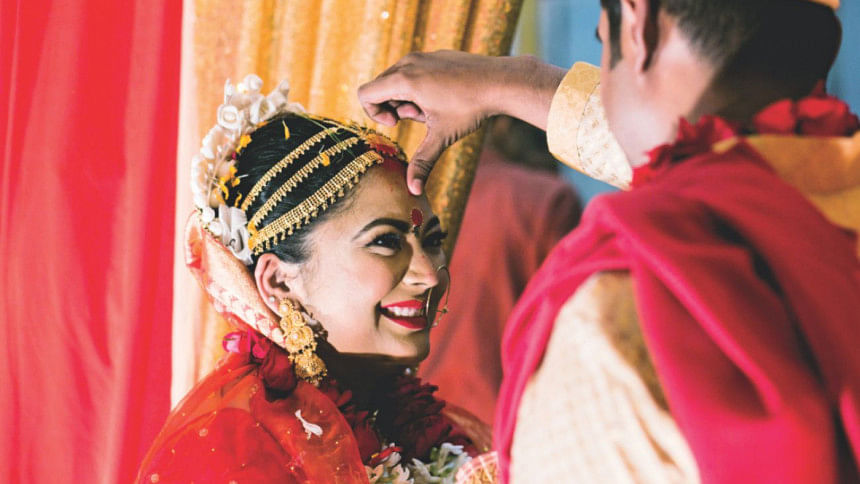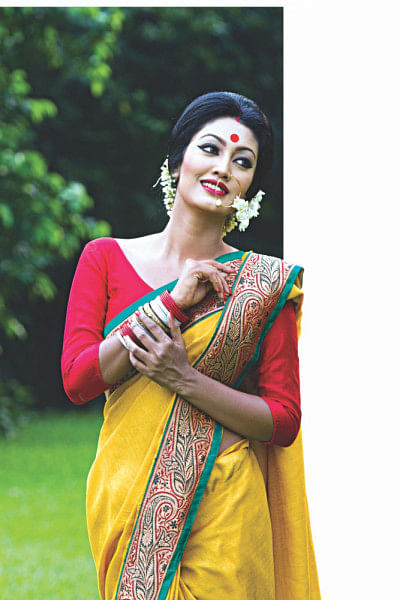Blessed Sindur

All it ever was, was red powder. Strip away the social practices, and the five-thousand-year-old myths, and all that's left in the palm is just some red tinted fine grains. But there is still something about it.
It was not when I completed the seven rounds around my husband before removing the beetle nut leaves (shubho drishti), although it was fun watching my now husband, sit still and not react as my younger sister poked and tugged at his hair every chance she got whilst I giggled at his irritancy; the mantras we chanted after the priest or the puffed rice (khoi) that we had to offer to the fire, or even watch both my siblings console one another as my husband and I completed the final seven circles around the fire that tied us as partners for even lifetimes to come.
But that one moment, when he looked at me and ever so delicately applied the sindur, or vermillion, on my hair's parting. It was at that moment I knew we had become one, a team that we had always wanted to be.
It was never the shankhas or polas that had made me feel that way. A sudden wave of emotions enveloped me as the realisation dawned that we were now married. Amidst the chaos and stress of any Bengali wedding, that, for me, was the most intimate moment I shared with my husband. No promises or vows were made. All it was, was just a look that we exchanged. The music had faded out, and the people around us no longer mattered. It almost felt like the world around us had stood still, as he filled the centre parting of my hair with vermillion.
Oh vermillion! You have given me such bliss, not because society now says that I am a "marked married" Hindu woman, or that my proprietorship has been transferred from my father to my husband's, it symbolises all the things I believe as a couple we had to go through to be here now; married and ready to take on the next phase of life.
It embodies the love, pain, disagreements and self-realisations we both had to experience as individuals and partners, and still chose to commit to one another. It is an indication of how we, now as an 'official' couple, choose to live out the rest of 'our' lives by the rules that we set for ourselves.

It took a minute to get used to tackling this red powder, personally and socially.
I remember, very vividly, the one time it ended up, not only at the centre parting of my hair, but regions above the left eye brow and the nose. There's a saying in Hindu culture that while applying vermillion, if a bit of it falls on the nose, then it is a sign of your husband's love.
Honestly, really didn't need to know that after having invested thirty minutes on doing my own makeup!
A word of advice, never use water to remove vermillion unless you're taking a shower! Did I forget to mention the one time I got told off by an elderly woman of another faith who said that my vermillion was not long enough for people to notice? Also, when did I suddenly become everyone's Didi, Didivai, Boudi or Boudimoni?
Aside from all that, I know my vermillion is not a societal or religious obligation, another reason to welcome unnecessary comments. I wear it for my husband, just as he wears his wedding band for his wife. It is not a sign of oppression or his dominance over me. He never asked to sacrifice anything, let alone me having to pray for him to be mine. Ours was a mutual commitment sealed through that one single act. The only thing we try to emulate from Shiva and Parvati's relationship was the love they shared for one another.
My sindur is my own,
I wear it for us
I wear it for our devotion to one another
My sindur is for none to judge!
Photo: LS Archive/Sazzad Ibne Sayed
Reels & Stories





Comments